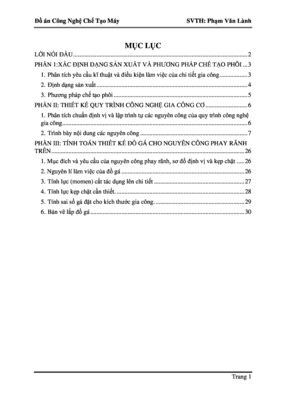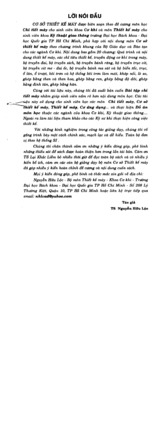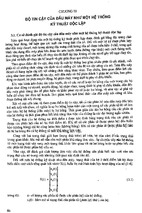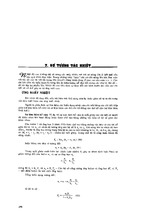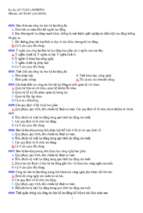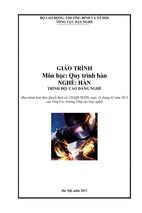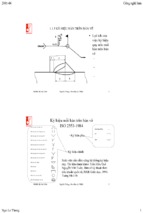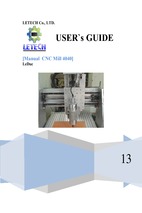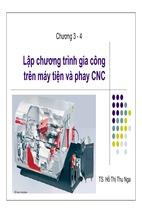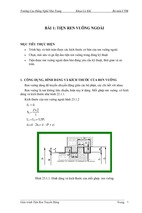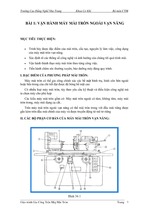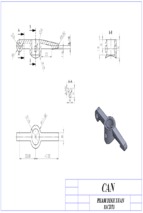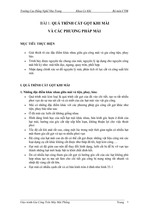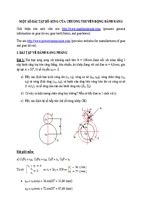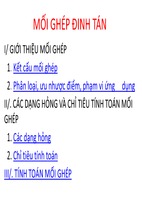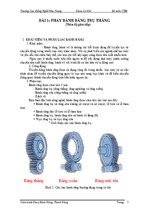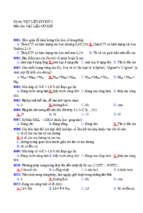Mô tả:
Generative Dynamic Response Analysis
CATIA V5 Training
Foils
Copyright DASSAULT SYSTEMES
Generative Dynamic
Response Analysis
Copyright DASSAULT SYSTEMES
Version 5 Release 19
September 2008
EDU_CAT_EN_GDY_FF_V5R19
Student Notes:
Generative Dynamic Response Analysis
About this course
Student Notes:
Objectives of the course
Upon completion of this course you will be able to:
- Understand the differences between harmonic and transient analyses
- Define load and restraint excitations
- Ensure that the appropriate pre-requisites are defined for the required
excitation case
- Visualize and animate 3D images of the analysis results
- Generate translation, velocity and acceleration graphs
- Export result data in Text or Excel format
Targeted audience
Structural Analysts
Copyright DASSAULT SYSTEMES
Prerequisites
Students attending this course should have knowledge of CATIA V5
Fundamentals, Generative Part Structural Analysis Fundamentals
Copyright DASSAULT SYSTEMES
0.5 day
Generative Dynamic Response Analysis
Student Notes:
Table of Contents
Introduction to Dynamic Analysis
What are the Different Types of Dynamic Analysis
Load or Restraint Excitation
Prerequisites
GDY Pre-Processing
Harmonic Response Case
Transient Response Case
To Sum Up
Results Visualization
Copyright DASSAULT SYSTEMES
Generating Images
Generating 2D Display
To Sum Up
Copyright DASSAULT SYSTEMES
4
5
6
7
8
9
31
51
52
53
57
64
Generative Dynamic Response Analysis
Introduction to Dynamic Analysis
Copyright DASSAULT SYSTEMES
You will see the different types of dynamic analysis and what they are for
Copyright DASSAULT SYSTEMES
Student Notes:
Generative Dynamic Response Analysis
What are the Different Types of Dynamic Analysis
A ‘Dynamic Response Case’ can be seen as a combination between a Static Case and a
Frequency Case
When you define a Dynamic analysis, you have the choice between 2 cases:
Harmonic Response Analysis
Transient Response Analysis
What are they for?
Harmonic Response Analysis:
You will define a such case if the amplitude of the excitation you are applying on a
part/assembly is fluctuating according to frequencies. Thus, it will allows you to answer
the question: What are the constraints and displacements in a part/assembly for given
frequencies?
Copyright DASSAULT SYSTEMES
Transient Response Analysis:
You will define a such case if the excitation you are applying on a part/assembly is
fluctuating according to the Time. Thus, it allows you to answer the question: What are
the constraints and displacements in a part/assembly after a given time?
Copyright DASSAULT SYSTEMES
Student Notes:
Generative Dynamic Response Analysis
Load and Restraint Excitation
CATIA allows you to define two different types of excitation.
Once you have chosen the type of dynamic response you want, you have to specify the nature of
the excitation. In both cases, you can either apply a “load” or a “restraint” excitation
Load Excitation Set: It allows to define a dynamic load, that will fluctuate according to the
frequency or the time, depending on the dynamic case you have chosen
Copyright DASSAULT SYSTEMES
Restraint Excitation set: It allows you to impose motion of the support, that will fluctuate
according to the frequency or the time, depending on the dynamic case you have chosen
Copyright DASSAULT SYSTEMES
Student Notes:
Generative Dynamic Response Analysis
Student Notes:
Prerequisites
When you define a dynamic analysis for the first time, you need:
Copyright DASSAULT SYSTEMES
Harmonic/Transient Analysis: Load Excitation
Pre-requisites
A computed static analysis with the Load
you want to excite
A computed frequency analysis that allows
you to know the modal frequencies
Copyright DASSAULT SYSTEMES
Harmonic/Transient Analysis: Restraint Excitation
Pre-requisites
A computed frequency analysis with that
allows you to know the modal frequencies
Generative Dynamic Response Analysis
GDY Pre-Processing
You will see how to define harmonic and transient dynamic case
Copyright DASSAULT SYSTEMES
Harmonic Response Case
Transient Response Case
To Sum Up
Copyright DASSAULT SYSTEMES
Student Notes:
Generative Dynamic Response Analysis
Harmonic Response Case
You will see different excitations cases used in Harmonic Response Analysis
Copyright DASSAULT SYSTEMES
Harmonic: Load Excitation Case
Harmonic: Restraint Excitation Case
To Sum Up
Copyright DASSAULT SYSTEMES
Student Notes:
Generative Dynamic Response Analysis
Harmonic: Load Excitation Case
Copyright DASSAULT SYSTEMES
You will see how to define a Harmonic Response Case with a Load Excitation
Copyright DASSAULT SYSTEMES
Student Notes:
Generative Dynamic Response Analysis
Student Notes:
General Process: Load Excitation
1
Compute a Static
analysis (loads and
restraints)
Meshed part
2
4
Define a frequency
Modulation file, damping,
load excitation
3
Define Dynamic Response case
referencing the frequency case
with a new Load excitation set
Compute a frequency
analysis referencing to the
restraints of the static case
6
5
Copyright DASSAULT SYSTEMES
Dynamic response
set computation
Copyright DASSAULT SYSTEMES
Results interpretation
2D Display
Local sensor
Generative Dynamic Response Analysis
Defining a Harmonic/Load Excitation Case
When defining a ‘Dynamic Response Case’ you have to select different data.
You must refer to the pre-computed
frequency analysis to take into account
the modal frequencies of the system.
When you define a dynamic case for the first
time, you have to check “New” load excitation.
Afterwards you can either select new excitation
or already created excitations as reference.
On the left, you can see a typical tree of
harmonic/load Excitation Case. Below are the main
components:
Copyright DASSAULT SYSTEMES
First, you can see the frequency Case you have
referred and the different solutions you had
displayed.
Load Excitation: that is a very important thing. It will
refer to the load of the pre-computed static analysis
and it is on this load that you will apply a
modulation. It means, you will have to define a
modulation file. ( cf. jobaids presented further)
For this case, you must have computed a
static and a frequency analysis.
Copyright DASSAULT SYSTEMES
Damping: Allows you to define the resulting damping
of the part once the force has been applied to this
part.
Student Notes:
Generative Dynamic Response Analysis
Defining a Frequency Modulation
The modulation is absolutely needed to define the load excitation.
Reminder: You want to compute a harmonic dynamic case. It means, the modulation must
describe the behavior of the amplitude versus the frequency. Thus, you will have create an
Excel or txt file.
Procedure to follow:
The first column must contain the frequency values. “ (Hz)” must be written
explicitly in the first cell. The values you define correspond to the excitation
frequency range. You can put as many values as you want (the steps). Values
must be in growing order.
The second column contains the amplitudes of the excitation for each
frequency.
It can take the values you want ( must be positive).
Once the modulation file is ready, you have to import it.
Copyright DASSAULT SYSTEMES
You can check its content by click on edit.
Copyright DASSAULT SYSTEMES
Student Notes:
Generative Dynamic Response Analysis
How to define White Noise Modulation
Remember that you have to import “modulation file” or define a “white noise
modulation” to be able to define a “Load Excitation Case”.
A White Noise Modulation is a particular case of frequency modulation:
The modulation is constant and equal to 1by default, used to get a uniform
modulation.
Click on
2
Click on OK
Copyright DASSAULT SYSTEMES
1
Copyright DASSAULT SYSTEMES
Student Notes:
Generative Dynamic Response Analysis
Defining a Load Excitation Set Case
You can not define a Load Excitation if you have not previously defined a modulation.
Frequency
Modulation :
From a file
Copyright DASSAULT SYSTEMES
white Noise
You must select the load on the previously computed static case. You must select a modulation:
either a customized one ( I.e from excel) or a white noise.
“Factor”: Value by which you multiply the modulation.
“Phase”: you can associate a phase component of dynamic load excitation.
Copyright DASSAULT SYSTEMES
Student Notes:
Generative Dynamic Response Analysis
Student Notes:
How to Define a Load Excitation Set Case
Before you begin, you must have defined either a “White Noise modulation”
(constant modulation) or have imported a modulation from a file. For more
information, see the following job aids:
1
Double-click the load excitation set from the specification tree
3
4
“Factor”: Value by which you multiply the
modulation
“Phase”: you can associate a phase component
of a dynamic load excitation
Copyright DASSAULT SYSTEMES
2
Copyright DASSAULT SYSTEMES
Select the load you want to
excite in the specification
tree
1
3
Select the desired modulation
in the specification tree
4
Define the desired Selected Factor
Generative Dynamic Response Analysis
Student Notes:
How to Define a Damping Set (1/3)
Defining a Damping Set allows you to define the resulting damping of the part once
the force has been applied to this part. You can choose between two damping types:
Modal (default) or Rayleigh
It is absolutely necessary to define a damping set for dynamic analysis. However, in opposition
to the modulation, a default value is automatically used if you do not define another one.
1
Double-click the damping set from the specification tree
The “damping” dialog box appears
Copyright DASSAULT SYSTEMES
2
Copyright DASSAULT SYSTEMES
Choose a damping type: “Modal” or “Rayleigh”
Generative Dynamic Response Analysis
Student Notes:
How to Define a Damping Set (2/3)
Modal Damping
The Modal Damping is a fraction of the
critical damping. The critical damping is
computed as follows:
The Rayleigh Damping is defined as
follows:
where m is the mass of the system and k
the stiffness of the system
where [M] is the mass matrix, [K] is the
stiffness matrix
3
Compute the frequency solution
(You have to compute the frequency
solution before defining the damping
parameters)
Copyright DASSAULT SYSTEMES
Rayleigh Damping
4
Click on the Component edition button
to define the damping parameters
The Damping Definition dialog box
appears
Copyright DASSAULT SYSTEMES
3
Compute the frequency solution
(You have to compute the frequency
solution before defining the damping
parameters)
4
Click on the Component edition button
to define the damping parameters
The Damping Definition dialog box
appears
Generative Dynamic Response Analysis
Student Notes:
How to Define a Damping Set (3/3)
Modal Damping
Definition mode by mode: lets you define the Alpha
(mass ratio) and/or Beta (stiffness ratio)
coefficients independently for each selected mode.
Multi-selection is available in this Case
Modify the Rayleigh damping
parameters and click on OK
6
Click
in the Damping dialog box
Copyright DASSAULT SYSTEMES
�
5
�
Click on
�
6
Modify the modal damping parameters and
click on OK
�
5
Global ratio: lets you define the Alpha (mass ratio)
and/or Beta (stiffness ratio) coefficients for all the
modes
��
Definition mode by mode: lets you define the
critical damping ratio independently for each
mode. Multi-selection is available in this case
��
Copyright DASSAULT SYSTEMES
Global ratio: lets you define the factor of the
critical damping for all the modes
Rayleigh Damping
in the Damping dialog box
Generative Dynamic Response Analysis
Harmonic Dynamic Response Set
Before you compute an analysis, you have to specify the frequency sampling.
Copyright DASSAULT SYSTEMES
The response is computed in the frequency domain on a regular sampling.
The minimum and the maximum sampling correspond to the lower and the upper bounds of
the frequency range of interest. The Number of steps corresponds to the number of
calculated points inside the frequency range.
To get more precision in the peak value, you can either increase the number of steps inside
the frequency range, or focus on the peak by choosing a smaller frequency range. The
second solution is better.
Copyright DASSAULT SYSTEMES
Student Notes:
- Xem thêm -


